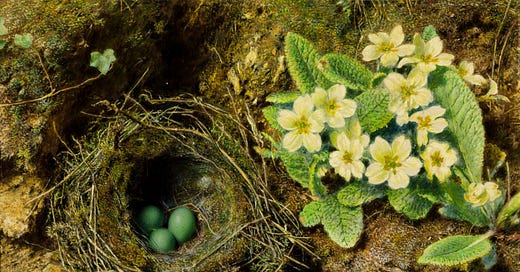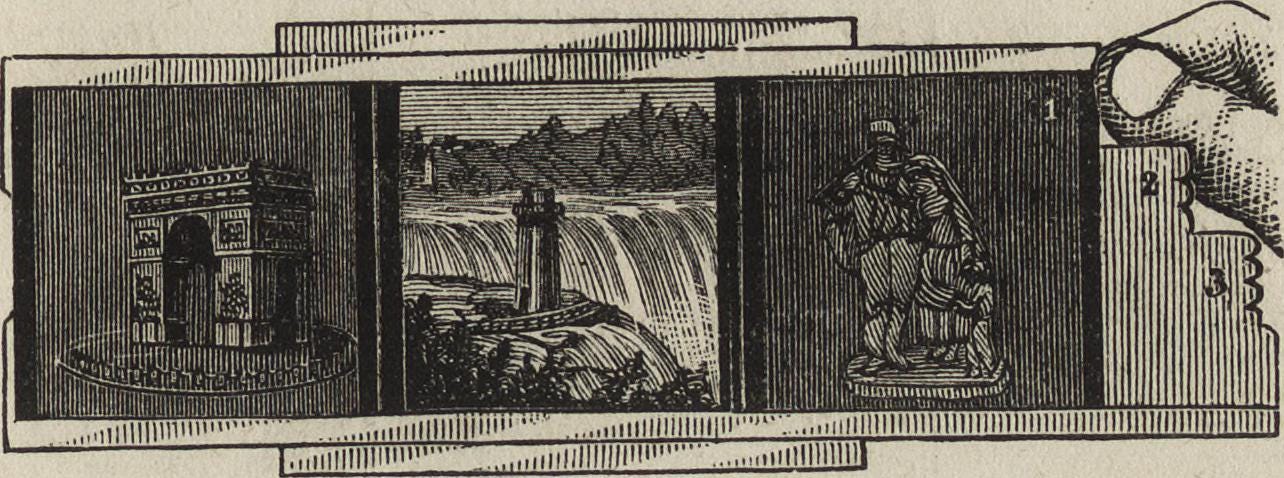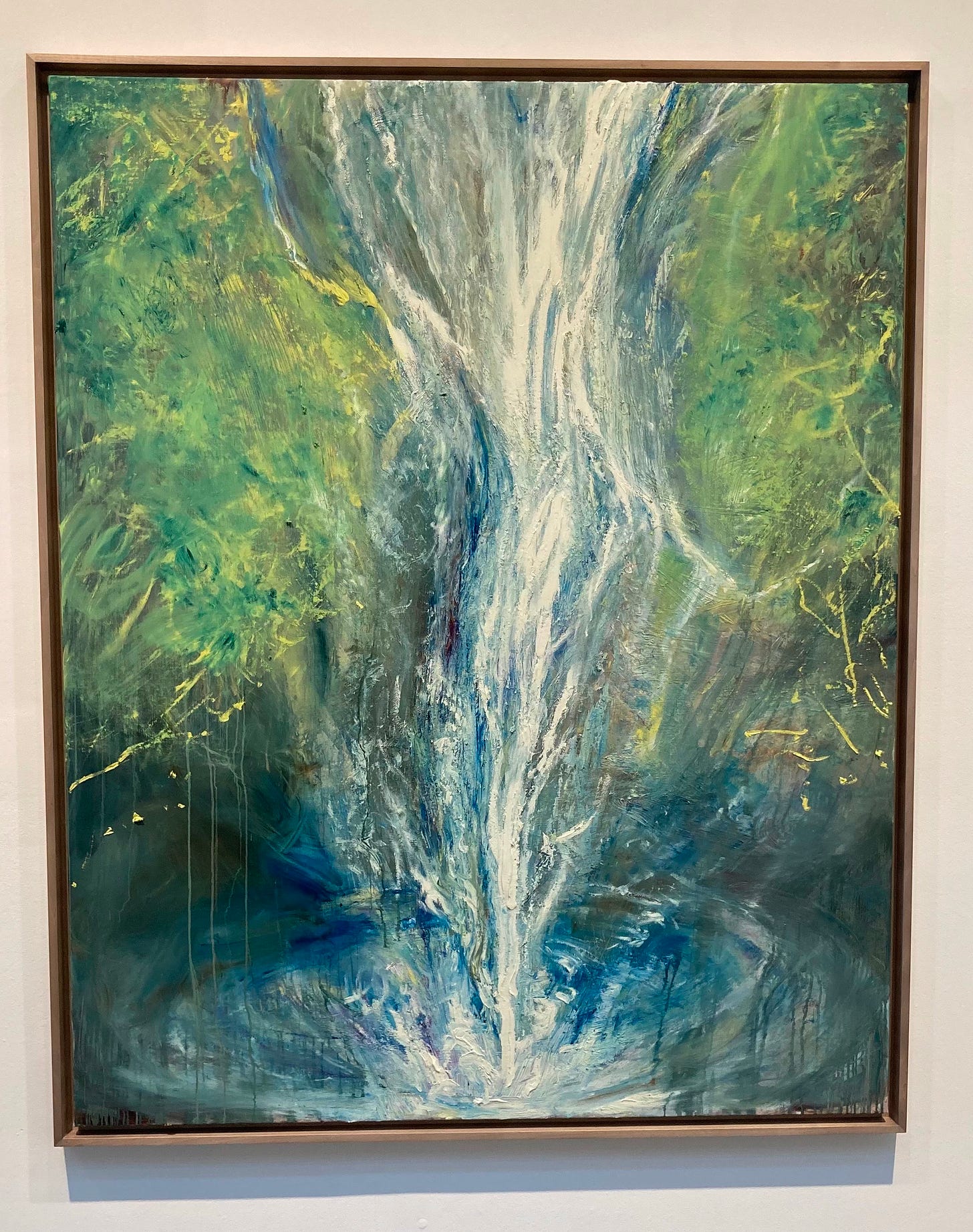Dear friends,
British watercolourist, William Henry Hunt, had a thing for painting bird’s nests; green with with moss, intricately shaped with yellow grasses and twigs. Gently placed at the base of a tree, as if softly fallen, they display their bounty of blue eggs to the viewer — the piercing turquoise shells of the Song Thrush, Blackbird, or the Dunnock; the paler, speckled blues of the Bullfinch, or the Starling. Unlikely perhaps, but, last year, as I was cutting back a climbing hydrangea, an old bird’s nest tumbled out landing on the ground with surprising grace, perfectly unharmed. The simple scenes are completed with leaves of creeping ivy and, most often, pale yellow primroses growing on the mossy bank. Reminiscent of spring walks under the cooling, dappled shade of an English woodland canopy, light reflecting sporadically from green leaves and petals, you can almost hear the birds sing.
Hunt’s pictures are heavily detailed and intricately observed from nature, anticipating the Pre-raphaelites, and earned him the moniker, ‘Bird’s Nest’ Hunt. His still life paintings were so popular that he found little time to paint anything else. John Ruskin described him as the finest painter of still life, writing in his manual, The Elements of Drawing, that students should emulate Hunt’s practice of creating mixed tints by interlacing the pure colours from which they are formed:
“Study the works of William Hunt, of the Old Water-color Society, in this respect, continually, and make frequent memoranda of the variegations in flowers; not painting the flower completely, but laying the ground colour of one petal, and painting the spots on it with studious precision.”
This year, in an effort to channel some of William Henry Hunt’s spring woodlands, I planted cowslips in the dappled shade of the mock orange, along the damp banks of the pond. The native, pale yellow primroses that were so abundant in Hunt’s woods, were so heavily plundered in the twentieth century that their dwindling numbers contributed to the 1975 ban on digging up wild flowers. Fortunately they have bounced back, and are now readily available in garden nurseries along with the Munstead strains introduced by Gertrude Jekyll in the nineteenth century. Named for her home in Surrey, Munstead Wood has recently been acquired by the National Trust and is at the top of my list as soon as it opens for visitors. In the meantime, I’ve bought a few primroses to brighten up the view from my own kitchen window.
Print — Jacob’s Room by Virginia Woolf, London, first published in 1922
Pictures — Celia Paul: Colony of Ghosts at Victoria Miro, London, until 17 April 2025
Print
Jacob’s Room by Virginia Woolf, London, first published in 1922
1922 was a big year; the birth of literary modernism. In the year that TS Eliot published The Waste Land, and Ulysses was printed in its complete form, Virginia Woolf established her style. Three years earlier she had grappled with the state of fiction in an essay for the Times Literary Supplement (reprinted as Modern Fiction), deploring the immense detail and heavy plotting of the Edwardian and Victorian novel.
“The writer seems constrained, not by his own free will but by some powerful and unscrupulous tyrant who has him in thrall, to provide a plot, to provide comedy, tragedy, love interest, and an air of probability embalming the whole so impeccable that if all his figures were to come to life they would find themselves dressed down to the last button of their coats in the fashion of the hour. The tyrant is obeyed; the novel is done to a turn. But sometimes, more and more often as time goes by, we suspect a momentary doubt, a spasm of rebellion, as the pages fill themselves in the customary way. Is life like this? Must novels be like this?”
With her third novel, Jacob’s Room, she answered that they did not. In hindsight, Woolf felt that, “I have found out how to begin (at 40) to say something in my own voice.” Jacob’s Room is an attempt to get at life, to show what life really is — constituted in small moments and frustratingly interior. She gives us lives divided by class and by gender. Lives inevitably separate, lonely and, perhaps, futile.
“Let us not take it for granted that life exists more fully in what is commonly thought big than in what is commonly thought small,” Woolf writes in Modern Fiction. Jacob’s Room proves her point. It’s a novel packed with seeds that would grow roots and branches in her later novels — Mrs Dalloway’s stream of consciousness; the creation of self in The Waves; what makes a life in The Years. But what fascinates me most about Jacob’s Room is the way Woolf seems to be talking double — both about the nature of identity and the role of an author herself. She reaches, in full view of her readers, for the solution to the problem of the modern novel.
At the crowded Opera House, she draws our attention to the ways in which the masses are divided and individuals set apart, whilst simultaneously exploring (as ‘I’) the author’s own difficult choices in distilling such a vast scene. What should be included, what left out, whose thoughts to trace; how to reveal life.
“The observer is choked with observations. Only to prevent us from being submerged by chaos, nature and society between them have arranged a system of classification which is simplicity itself; stalls, boxes, amphitheatre, gallery. The moulds are filled nightly. There is no need to distinguish details. But the difficulty remains — one has to choose. For though I have no wish to be Queen of England — or only for a moment — I would willingly sit beside her… And then doffing one’s own headpiece, how strange to assume for a moment some one’s — any one’s — to be a man of valour who has ruled the empire… But no — we must choose. Never was there a harsher necessity! or one which entails greater pain, more certain disaster; for wherever I seat myself, I die in exile.”
A few paragraphs later, Woolf explores how nebulous identity is; how difficult ‘character’. The self cannot be separated from context. Perhaps it cannot truly be captured in the novel form, which demands cutting, and stitching, emphasising and omitting. And yet the writer is compelled to try.
“There remains something which can never be conveyed to a second person save by Jacob himself. Moreover, part of this is not Jacob but Richard Bonamy — the room; the market carts; the hour; the very moment of history… But something is always impelling one to hum vibrating, like the hawk moth, at the mouth of the cavern of mystery, endowing Jacob Flanders with all sorts of qualities he had not at all — for though, certainly, he sat talking to Bonamy, half of what he said was too dull to repeat; much unintelligible (about unknown people and Parliament); what remains is mostly a matter of guess work. Yet over him we hang vibrating.”
We cannot ever really know each other. For Woolf any attempt to get at the self — at character — is fleeting, ephemeral. And yet our contact with other people creates an intensity within us that is unparalleled. “Why,” she writes, “are we yet surprised in the window corner by a sudden vision that the young man in the chair is of all things in the world the most real, the most solid, the best known to us — why indeed? For the moment after we know nothing about him.” I recall the difficulty of poetry in Woolf’s Orlando and Between the Acts, ideas slipping away before they can be articulated. And I’m reminded of something all together more recent — Sally Rooney’s Intermezzo — in which the inadequacy of language itself, reflects and shapes the binary nature of perception. People are this or they are that, our labels defying the nuance that pervades life and experience.
What Woolf seems to show us, in Jacob’s Room, is how much of life slips through our fingers, how little of it we understand. That we can feel — that we can love — without ever truly knowing someone is, perhaps, the greatest feat of human nature. And perhaps, the source of our undoing.
“Such is the manner if our seeing. Such the conditions of our love.”
Pictures
Celia Paul: Colony of Ghosts at Victoria Miro, London, until 17 April 2025
“My memories are more alive than my present existence”
The long awaited monograph of Celia Paul’s work, celebrated in a new exhibition at Victoria Miro in London, arrives at an interesting time. With the death of Frank Auberach last November, the older male artists whose work overshadowed Paul’s early career have passed into memory. So too has Paul’s mother (her most frequent sitter) and her husband Steven Kupfer. “I am alone now,” she writes, “yet the painted world I live in has accrued substance.” It can be seen in the very smock she wears — spattered and encrusted, stiff with a lifetime’s errant paint.
There is an inevitable looking back. Ghost of a Girl with an Egg (2022) is a direct response to Lucian Freud’s Naked Girl with Egg, painted forty years earlier, for which Paul sat. She describes the experience in her book, Self-Portrait.
“I was very conscious of my flesh, and I felt myself to be undesirable… When he came to painting my breasts, I felt his scrutiny intensify. I felt exposed and hated the feeling. I cried throughout these sessions.”
Paul writes without censure but it is difficult to read these passages without projecting one’s own. Thirty-six years her senior, Freud was not only Paul’s teacher at the Slade art school but her lover from the age of eighteen. Perhaps this is why seeing Ghost of a Girl with an Egg feels so profound; something has shifted since the death of Freud. On the neighbouring wall, her self portrait Reclining Painter looks across at Colony of Ghosts — washed out in an spectral palette of grey-green, Lucian Freud, Francis Bacon, Frank Auberach, and Michael Andrews return her gaze. The masculine art world, of which Paul was never fully part, is no more. She has stepped into her own power.
I’m drawn to the ways in which Paul has rejected conventional expectations of womanhood in order to preserve her identity as an artist. In her book, Letters to Gwen John, she explores the obsessive nature of Gwen’s relationships, the unattainability of both (Gwen’s lover) Rodin and Freud, and the effect of this emotional turbulence on their work. Sterile, unproductive periods and artistic failures reveal their need for emotional stillness and private space. Paul describes her inability to focus on more than one project at a time; the need for calm, without deadlines or emotional disturbances: “My energy flows inwards, not outwards.” Somewhat controversially, Celia Paul chose not to live with her husband or her child, transferring the responsibility for her child’s care to her mother. She describes the anguish of this choice, the inescapability of maternal love. Thinking about the women she has admired, Celia Paul realises they were all childless: “They could observe quietly without being distracted.”
I am reminded of Virginia Woolf’s essay, A Room of One’s Own, in which she contends financial independence and domestic freedom are essential for women writers and the creative process. She writes of the British Museum, domed and “encircled by a band of famous names” — the names of great men. In her novel, Jacob’s Room, this leads feminist Julia Hedge to declare “Oh damn, why didn’t they leave room for an Eliot or a Brontë?” It is an odd coincidence that Celia Paul has spent her life living opposite the very same British Museum, painting its facade in shifting light. Her own rooms, meanwhile, kept “as inhospitable as possible in order to ward off any potential intrusion.”
In 2020, as the coronavirus pandemic changed lives globally, Paul retreated to Pembrokeshire. All that could now be offered to her husband, Steven Kupfer, was palliative chemotherapy and painting paths gave her the chance, “to regain a sense of how I need to arrange my life.” Paul’s most recent nature paintings, Force (2024) and The Mouth of the Cave, suggest renewal and hope, an acceptance of life’s mystery. There’s something transcendental and otherworldly about their yellow and white light, and calming blue-greens. Standing before the vast canvas of The Sea, The Sea, its edges beyond my peripheral vision, I thought about the way in which Paul ties nature to grief, time and memory. In Self-Portrait:
“I made studies on the beach at Lee Abbey. I watched how one can clearly see the wave as it approaches, and the traces of it as it pulled back again by the drag of the tide, but that when the wave was actually in the process of breaking, it is impossible to witness what is happening in the chaos of splintering water. It made me think about how impossible it is to live fully in the present. I recognise the impossibility, but also the necessity of trying.
“I made studies of the waterfall that courses its way through the steeply banked woods and over boulders until it joins the beach, where it fans out and trickles towards the sea. I thought of my mother’s life. I thought of her courage and spirit and the powers of her endurance.”
At Victoria Miro we get a sense of Paul’s own endurance too. In the accompanying monograph she tells us:
“I want the self-portraits I make from now on to convey a different sort of security. My recent self-portraits – which I am pleased with – owe their success to the power of my defiance. “I am a survivor” they are clearly saying. I am self-enclosed, as if the paint is my armour.”
Thank you so much for taking the time to read this post, your support means a lot. If you enjoyed this newsletter please share it with your friends, or subscribe to get future editions direct to your inbox.
This month’s featured image is ‘Primroses & Bird’s Nest’ by William Henry Hunt. Banners are courtesy of the Internet Book Archive.











Thank you for this wonderful piece! Lots of lovely different threads. I have become increasingly captivated by Celia Paul since reading Self-Portrait last year & am hoping to see her exhibition (or at least get the monograph)
'Our labels defying the nuance that pervades life'. This is so relevant in our label-obsessed era.